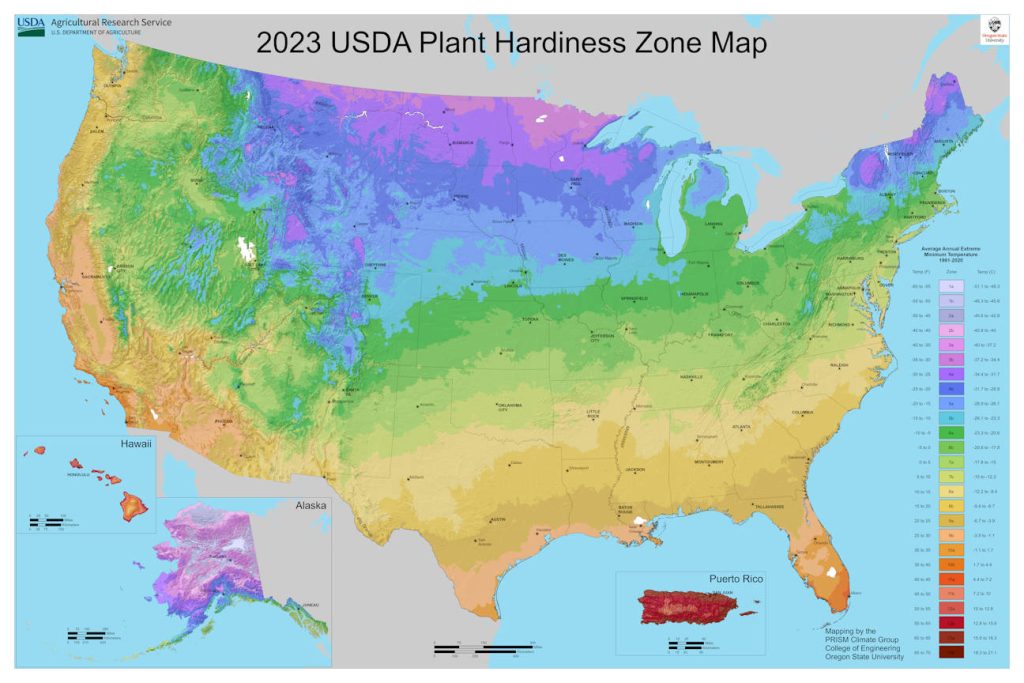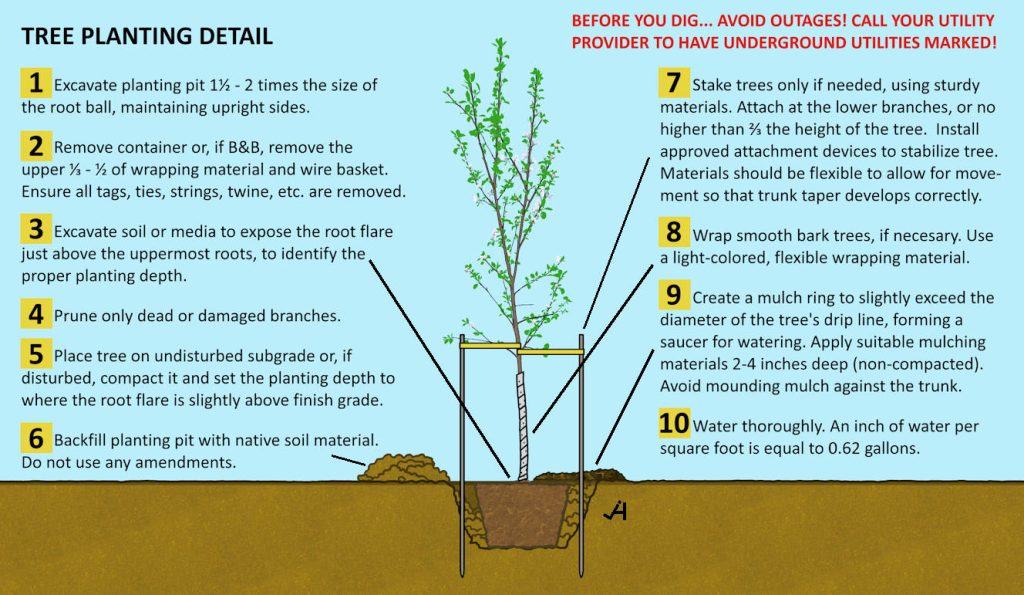[Last update: November 2025]
Quick Links to Topics Covered in This Article:
INTRODUCTION • Before, During, and After Tree Planting
Location, Location, Location • Tree Selection
Proper Planting • Good Cultural Practices
High pH Indiana Soils: What Trees Can I Plant? • High pH Indiana Soils: Trees to AVOID
INTRODUCTION: Have you ever wondered, “What is the proper way to plant a tree?” and does it really matter?
Sometimes, it’s hard to imagine the “future tree” it has the potential to become, for example, how tall it will grow, how much shade it will produce, etc.
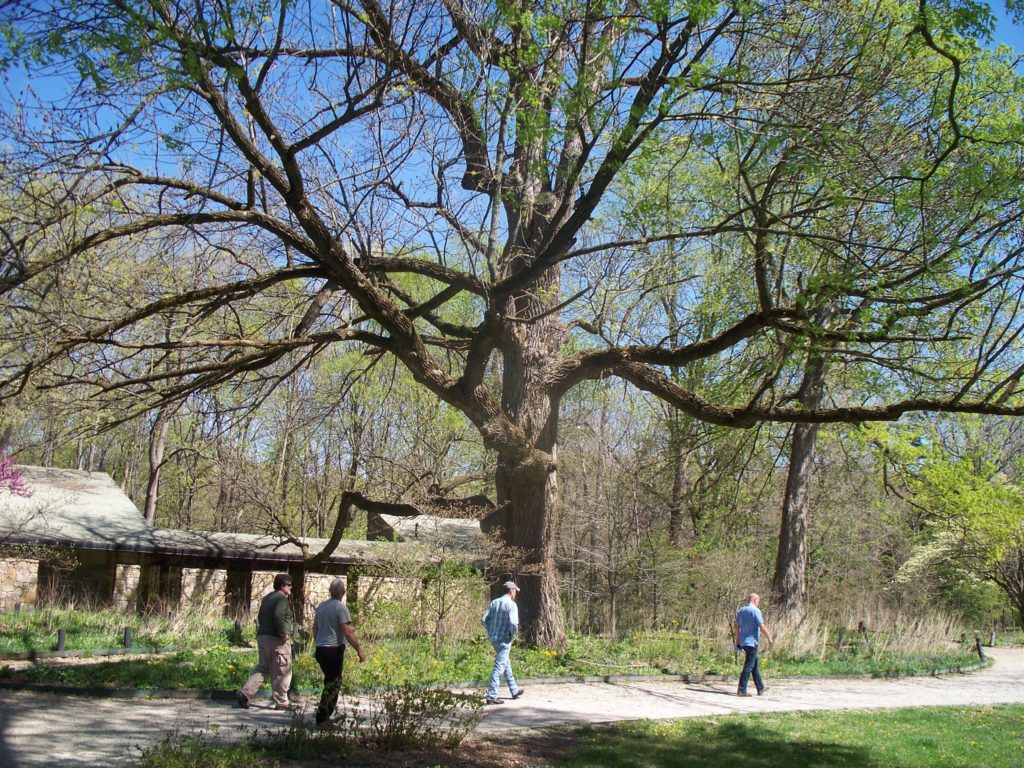
200-yr-old White Ash behind Holliday Park Nature Center (Indianapolis)
It’s kind of like buying a cute little puppy. It’s small, -doesn’t take up much room, and did we mention it’s cute?!! Before you realize it, it becomes a larger dog that eats more, poops more, and takes up more space. You still love your dog, but over time, your responsibilities in maintaining your pet have increased. You do more things to keep it happy, well-fed, healthy, and comfortable. Similarly, the change over time in addressing the needs of your trees will grow!
If you are thinking about planting one (or more) trees, how will you keep them “happy, well-fed, healthy, and comfortable?”
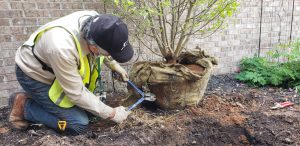
After removing excess soil around the trunk and checking for girdling roots, the rootball transport materials (twine, upper third to half of burlap and wire basket) are removed.
First, you have to plan for it! Why do you want to plant a tree? Are you planting it yourself, with family or friends, or for-hire? Have you had the soil tested? What kind of tree do you want? Are nearby utility lines a concern? From where will you purchase it? When is the best time to plant a tree? (See “Planting New Trees – Spring, Fall, or When?”) How much space is available for one? Will it hide your property as a natural barrier (a.k.a., privacy fence)? Will it kill your lawn from too much shade? Will you have time to care for its needs properly? Etc.
Yes… There is much to consider before planting a tree, but don’t let that stop you or discourage your desire to own one! Just keep in mind that for the best success in owning a tree and maximizing your enjoyment for decades to come, they do require your attention at times while doing their thing. Take some time to learn about them and seek expert advice before spending your hard-earned cash. Not every tree will grow well in every location. There’s a ‘right tree for the right place!’
BEFORE, DURING, and AFTER TREE PLANTING
We’ve put together a list of reminders on what we believe to be the most important things that MUST happen to provide a new tree the best chance for a long, productive life in its new home:
SOIL TESTING:
If you haven’t done so already, get a soil test FIRST to get an overview of your planting site’s soil condition. Even native trees can struggle in the wrong soil conditions. (See list of Indiana trees that tolerate high alkaline soil.)
Typically, when we order a soil analysis, we ask the laboratory to test for the following things: organic matter, available Phosphorus, exchangeable Potassium, Magnesium, Calcium, soil pH, buffer pH, cation exchange capacity (CEC), percent base saturation of cation element, soluble salts and Sodium, along with Sulfur, Zinc, Manganese, Iron, Copper, and Boron
While we may not need to use all of this data in every planting instance, it’s good data to have on hand. Our focus is primarily on existing trees on a property and potential new tree plantings, but not necessarily the turfgrass. (We leave that to the lawn care guys!😉) However, it works in the best interests of the property owner and their trees when arborists and lawn care providers work in harmony with each other to avoid misaligned treatments!
NOTE: You will not need to repeat the soil testing process unless significant soil changes have occurred, like regrading or topdressing in your lawn or landscape.
LOCATION, LOCATION, LOCATION:
VERY IMPORTANT: You’ve probably heard or seen the expression, “Right tree, right place.” Before setting your heart on a tree species, be sure that it will be small enough or large enough for the site you wish to plant it into. Always research a tree’s growth potential statistics. How tall could this species get? How wide? Is it prone to surface roots? etc. Avoid trees that could grow tall enough to affect overhead power lines or that could obstruct traffic signs or block utility access points and right-of-ways. The wrong tree planted in the wrong place will likely result in conflicts and extra expenses for you in the future, including removal.
Also, try to find a species or a species cultivar that shows natural resistance to pests and diseases. the term “resistant” should not be confused with the word “immune” because they are not the same thing. A tree that has resistance to a particular disease, for example, may last longer and potentially avoid getting ill as opposed to another tree of that same species that is more susceptible, but complete immunity can not be guaranteed. All transplanted trees will usually require some form of care and maintenance at some point in their life. Try to select a species that best fits your location and will meet your target maintenance goals and budget.
Be sure to inspect candidate trees before purchasing them to avoid receiving defective or poorly structured trees. Select healthy tree specimens with good form (including roots). The likelihood of higher maintenance is increased substantially by purchasing and planting a tree that already has significant defects or a problematic structure. If you hire someone else to pick your tree(s), you likely won’t be able to inspect the trees before they are purchased. Therefore, if you leave this step to the tree installer, you should include in your service agreement a clause allowing you to exercise your right of refusal if the tree selected is in poor condition or bad form before they plant it and to clearly state a tree replacement warranty period.
Some dealers may try to sell you on a tree by calling their defects “unique” or saying it gives the tree “character,” but beware! True, it does offer uniqueness, but just like a topiary pruned shrub, it will require diligence and dedication to maintain and preserve that “character” you so love. Therefore, use caution. Never blindly buy a tree! Inspect it first or have a qualified arborist inspect it for you.
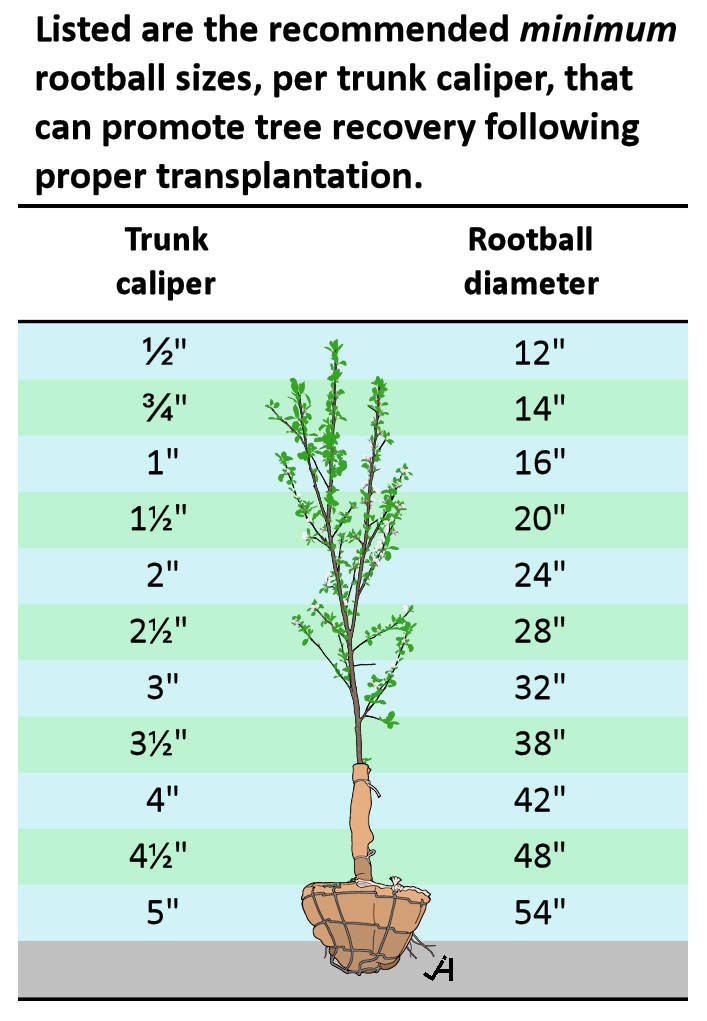
When selecting trees, look to match the caliper size with the rootball diameter. The larger the rootball per trunk caliper will increase the chances for quicker recovery from transplant shock and aid in establishing roots sooner.
AVOID PURCHASING INVASIVE SPECIES!!! Purchasing invasive trees is detrimental because they damage local ecosystems, cause economic harm, and may create long-term problems for your own property. These non-native species outcompete native plants for resources and disrupt the food web, negatively impacting wildlife.
PROPER PLANTING:
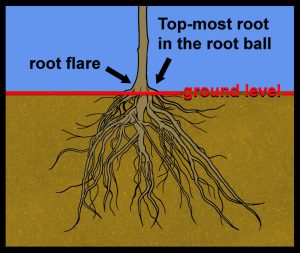
Plant your tree where the root flare (sometimes referred to as trunk flare) is at grade (ground) level.
Proper depth is important. Ensure that the tree’s root/trunk flare is planted at grade level. New trees may find it challenging to establish roots in highly compacted soil. Widening your planting hole may be necessary to reduce soil compaction when you backfill the hole.
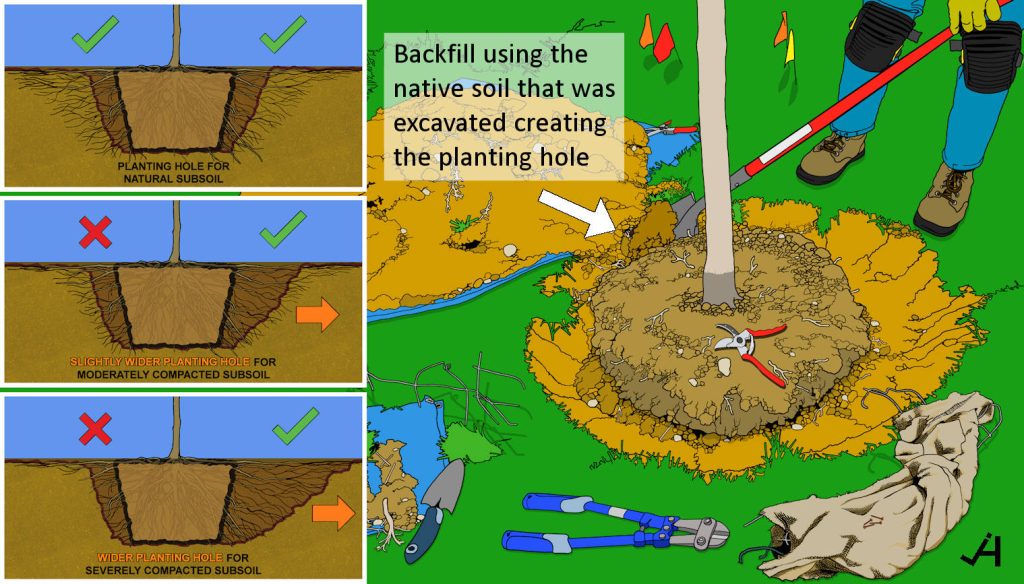
Planting in Compacted Soil will require excavating a wider hole. Break up the backfill soil to make it less compacted and encourage root establishment.
GOOD CULTURAL PRACTICES:
Ensure the tree will be properly cared for to help them overcome transplant shock and establish strong roots. There are A LOT of initiatives to “Save the World” by planting a gazillion trees, but who’s taking care of them? Intending to save costs, the budgets allocated for these ‘green initiatives’ typically only pay for the trees and are planted by volunteer workers. Many of these events omit a program to manage ongoing care after the planting event. As a result, these trees are often not properly managed. Just take a drive and see the dying/dead trees that were planted en masse in prior years during a special Earth Day or Arbor Day celebration or following a widely-publicized urban canopy restoration initiative. Relying on the public, particularly in local impoverished neighborhoods, to care for such trees doesn’t always work out. So, on your property, if you desire to plant new trees that are successful, you will have to plan for their care and use good cultural practices. These practices are fundamental to the tree’s health and survival and are often necessary during the first three years of growth.
What do these practices include?
-
- WATERING YOUR TREES ADEQUATELY: For one, trees need sufficient water to survive. It’s a basic, but an essential requirement. Ensure the tree receives adequate irrigation. Most new trees die due to a lack of sufficient water, either too little or too much. Water is the best first life-saving resource over any treatment!
- MULCHING AROUND YOUR TREES PROPERLY: Trees also need to be protected from mechanical injuries such as mower damage, weed-trimmer damage, etc. This is a common problem that a few lawn mowing professionals neglect to give proper attention to. As far as landscape aesthetics go, if mulch is to be put around your trees it needs to be applied properly to benefit not just “curb appeal” but more importantly, plant health. (If you are unfamiliar with what proper mulching means and why that is important, then consider this a polite wake-up call.)
- PRUNING YOUR TREES PROPERLY: Trees may eventually need some maintenance pruning. However, if pruning is not done properly, it can ruin a tree for life. Bad cuts and even tree topping are constantly being committed by individuals and small businesses who genuinely don’t recognize the harm done to trees, or they top trees deliberately and try to downplay the harm to trees. Hint: Science, research, studies, and evidence prove that trees don’t respond well to being topped and never will.
- SUPPLEMENTING WITH VITAL NUTRIENTS, AS NEEDED: Occasionally, poor soil conditions may require you to intervene and provide your trees with supplemental nutrients, but don’t just apply any fertilizer on it. Use your soil test results to guide you or your arborist in selecting appropriate fertilizers to restore vigor and health to your trees. The soil analysis may reveal your soil already has plenty of certain nutrients, but a lack of vital nutrients can cause low tree vigor and make your tree more susceptible to disease, and also attract additional pest problems.
- MANAGING PESTS AND DISEASES: Addressing pests, particularly exotic pests, and diseases that harm the health and vigor of your trees must be managed. Some trees are more susceptible than others, and it may depend on the species on what problems they may face in the future, and the potential of how detrimental problems could become. Still, when life-threatening health issues arise, these must be addressed promptly, usually with the aid of a qualified, trained & experienced professional. Keep in mind that these professionals are not gods, and there are some diseases that scientific research has yet to cure. Dure or not, ALL trees will eventually die over time from any number of reasons, some undetectable.
-
- Black Maple (Acer nigrum), but beware of Asian Longhorn Beetle!
- Boxelder (Acer negundo), but beware of Asian Longhorn Beetle!
- Northern Catalpa (Catalpa speciosa)
- Common Hackberry (Celtis occidentalis), but beware of Asian Longhorn Beetle!
- Eastern Redbud (Cercis canadensis)
- Yellowwood (Cladrastis kentukea)
- Cockspur Hawthorn (Crataegus crusgalli)
- Downy Hawthorn (Crataegus mollis)
- Green Ash (Fraxinus pennsylvanica), but beware of Emerald Ash Borer and Asian Longhorn Beetle!
- Kentucky Coffeetree (Gymnocladus dioicus)
- Honeylocust (Gleditsia triacanthos)
- Eastern Red Cedar (Juniperus virginiana)
- Crabapple (Malus spp.)
- American Hophornbeam (Ironwood) (Ostrya virginiana)
- American Sycamore (Platanus occidentalis), but beware of Asian Longhorn Beetle!
- Eastern Cottonwood (Populus deltoides), but beware of Asian Longhorn Beetle!
- Bur Oak (Quercus macrocarpa)
- Chinkapin Oak (Quercus muelenberghii)
- Black Locust (Robinia pseudoacacia), though sometimes prolific
- American Linden (Tilia americana)
- Elms (Ulmus spp.) Purchase only Dutch elm disease (DED) resistant hybrids (such as ‘Triumph’, ‘Accolade’, and ‘Commendation’) or DED-tolerant American Elms, but beware of Asian Longhorn Beetle!
Non-native Species (Non-invasive)
-
- Ruby Red Horsechestnut (Aesculus carnea), but beware of Asian Longhorn Beetle!
- Katsura Tree (Cercidiphyllum japonicum), but beware of Asian Longhorn Beetle!
- Hardy Rubber Tree (Eucommia ulmoides)
- Ginkgo (Ginkgo biloba)
- Black Spruce (Picea mariana)
- Silver Linden (Tilia tomentosa)
Trees to AVOID
-
- Firs (Abies spp.)
- Red Maple (Acer rubrum) requires more acidic conditions than what is typical in Indiana, and high pH can impact its growth, also beware of the Asian Longhorn Beetle! (Update: Redpointe Red Maple (Acer rubrum ‘Frank Jr.’ PP 16769) appears to do fairly well in high pH soils, and so this may be a welcome exception to the rule of ‘trees to avoid’. See more info about this introduced variety here.)
- River Birch (Betula nigra), but beware of Asian Longhorn Beetle!
- Dogwood (Cornus spp.)
- American Sweetgum (Liquidambar styraciflua)
- Spruces (Picea spp.)
- Pines (Pinus spp.), especially white and yellow pines, require a pH of 5.2 to 6.0 and will show signs of stress, like yellowing needles, in higher pH soils
- Pin Oak (Quercus palustris) is often cited as a species that struggles in high pH soils
- Bald Cypress (Taxodium distichum)
- Hemlock (Tsuga)
-
- ISA “Planting Details and Specifications” https://wwv.isa-arbor.com/education/onlineresources/cadplanningspecifications
- Indiana Department of Natural Resources (INDR/CUF) Community & Urban Forestry https://www.in.gov/dnr/forestry/programs/community-and-urban-forestry/publications/
- Purdue University Publications & Videos:
“Consumer Horticulture: Collecting Soil Samples for Testing” https://mdc.itap.purdue.edu/item.asp?Item_Number=HO-71-W
“Indiana Tree Species Selection Guide”(PDF) https://www.in.gov/dnr/forestry/files/fw-tree-species-selection-guide.pdf
“Tree Planting Part 1: Choosing a Tree” (VIDEO) https://youtu.be/iIaYvtqY7-I
“Tree Planting Part 2: Planting Your Tree” (VIDEO) https://youtu.be/k5rUgd7BmiA
“Tree Installation: Process and Practices” (PDF) https://www.extension.purdue.edu/extmedia/FNR/FNR-433-W.pdf
“Planning the Tree Planting Operation” https://mdc.itap.purdue.edu/item.asp?Item_Number=FNR-223
“Tree Pruning Essentials” https://mdc.itap.purdue.edu/item.asp?Item_Number=FNR-506-W
“Tree Pruning: What Do Trees Think?” https://mdc.itap.purdue.edu/item.asp?Item_Number=FNR-534-W
One more thing before you plant that new tree in Indiana…
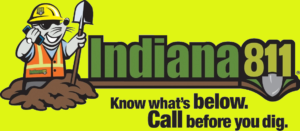
DON’T TAKE CHANCES! Call 8-1-1 BEFORE you dig!
Knowing where underground utility lines are buried before each digging project begins helps to prevent injury, expense, and penalties. The depth of utility lines may vary, and multiple utility lines may exist in one area. Simple digging jobs can damage utility lines and disrupt vital services to an entire neighborhood, harm those who dig, and result in expensive fines and repair costs. Marked lines show those who dig the approximate location of underground lines and help prevent undesired consequences.

